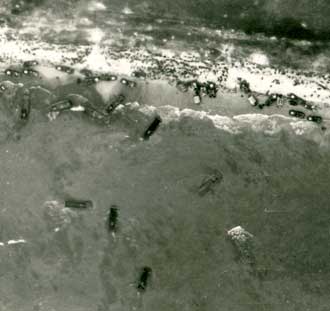By Bryan Newbury
September 27, 2007
 “Gentlemen, this is it.†This was Quentin Aaneson’s introduction to combat. Over Omaha Beach, D-Day, Phase Two.Â
“Gentlemen, this is it.†This was Quentin Aaneson’s introduction to combat. Over Omaha Beach, D-Day, Phase Two.Â
Episode Four begins with the climactic scenes from the Normandy Invasion. It has been nearly seven hours to this point, and The War is intent on the payoff. After the first three offerings in the series, the accounts of the three phase European entry almost take the viewer by surprise. It has been noted, and Burns has admitted as much, that The War did not seek to go in a conventional direction; rather, it was conceived as a multi-faceted project that seeks to document the war in ways we haven’t seen time and again. The ways of retelling it that made it a knowing joke that the big “H†on the bottom of your screen stood for The Hitler Channel.
This technique is risky. When an artist of any sort attempts to take on a subject of this nature, he is caught in a sort of… forgive me… Catch 22. He can’t tread the well-worn soils that countless others have walked. He must make it new. However, when endeavoring to make it new, he runs the risk of marginalizing major events and shining a spotlight on the marginal ones. To evade this Daedalus design, he is forced to give great sway to the biggest of the big events, while portraying the surrounding events in a novel manner. So far, Ken Burns has managed to avoid the Minotaur. It is early yet to imagine The War as his Ariadne.
Episode Four is great filmmaking. It is also quite a chink in the armor of this series.Â
The inherent difficulty in focusing on the personal stories of America and four of her cities at war is that war, by definition, is a rather dramatic enterprise. Pride of a Nation is filled with the drama, the strategy, the blood and toil of battle. As such, it feels a bit out of place.Â
Assume, for a moment, that a person started watching The War with little knowledge of World War II. It isn’t exactly a fair assumption, considering the fact that, more than any event in recent history, World War II is omnipresent. Twenty years from now, who knows? When an artist conceives something on this scale, it is fair to apply the twenty-year test. By that time, the attention span of the American public could make that hypothetical citizen a very believable quantity. What might this John Doe take away from the series?Â
Again, it isn’t quite fair. Though mammoth in scope, no one imagines that Ken Burns would wish to create the authoritative film history of World War II. If that is the case, why not focus firmly on one event, one campaign, one theater, one city, one soldier, one soldier’s wife? By setting it so broadly, he becomes vulnerable to criticism that would otherwise be absurdly rash.
D-Day does loom large, especially when viewing the war from a very American perspective. (Will there be the stories of German citizens cowering under aerial attack? If one wanted to bring the American viewing public a different angle from which to view the war, this would certainly be a golden subject.) The rub is that, by focusing in on D-Day, it only diminishes the three years of battle that led up to it. Besides, how much is left to see from the Normandy Invasion?Â
Saipan is another watershed, and again, Episode Four delivers on its historical representation of just what we imagine those battles must’ve been like. The counterpoint of the 442nd is well-placed. While witnessing the attitude of the Japanese, from admiral to civilian child, choosing suicide over surrender, we get a kind reminder that this outlook served us nicely in the European theater, courtesy of our own Japanese-American soldiers once they were allowed to prove their patriotism. This does the job in maintaining an intellectual balance. This does not solve the imbalance of the first four episodes as a whole.
With three installments to go, our filmmaker is staring down the white bull’s horns. His personal history is getting hijacked by the larger-than-life events that surround the people in question. Unfortunately, the Japanese penchant for shunning surrender feels like a setup for the events of August 1945. It is too early to assume that this will be the case, and possibly we are being fooled with a bit, but if the cynical bombings of Hiroshima and Nagasaki (or even the firebombing of Tokyo) are glossed with the “We had to do it†routine, all could be lost.Â
From what we’ve seen thus far, this reviewer is inclined to doubt a ten-thumbed conclusion, with the bunker, Truman’s good faith, and the spawning of suburbia playing out to rosy credits. It is also hard to imagine that the final three episodes will serve to form a coherent project. Should they accomplish this, we might want to find out just who gave Ken Burns the yarn.Â
O, I do love cliffhangers.
—–
Click here to read all of Newbury’s writing on The War.
A film by Ken Burns
Color and Black & White, 2007



